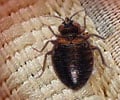- Relapsing Fever - (http://www.columbia-lyme.org/patients/tbd_relapsing.html)
- Tick-borne Relapsing Fever (TBRF) - (https://www.cdc.gov/relapsing-fever/index.html)
- Familial Mediterranean fever - (https://ghr.nlm.nih.gov/condition/familial-mediterranean-fever#genes)
What is Relapsing Fever?
Relapsing fever is a vector-borne bacterial infection which is caused by Borrelia spirochetes.
Based on the type of vector that spreads relapsing fever, there are two main types of relapsing fever:
Tick-borne relapsing fever
- Tick-borne relapsing fever has been seen in Saudi Arabia, Asia, Africa, Spain, Western areas of United States, Canada.
- It is caused by several Borrelia species like Borrelia hermsii, Borrelia duttoni, and Borrelia parkerii.
- The tick species responsible for transmission is seen mostly on small mammals like mice and squirrel. The bites are painless and during the night thus often not recollected by the victims.
- This infection is seen commonly in rodent infested areas.
Louse-borne relapsing fever
- Louse borne relapsing fever is commonly seen in developing countries of Asia and Africa.
- The bacterial species that is linked with louse-borne relapsing fever is Borrelia recurrentis.
- This infection as the name suggests is carried from human to human by the body louse or Pediculus humanus humanus. Here the pathogenic organism multiplies in the body louse and gets transmitted to the human when it is crushed while feeding on the human. The infection passes on to other uninfected lice when they feed on the infected human.
- It is commonly seen in low hygiene settings in conditions of war, slums and overcrowding. This infection has an epidemic nature.
What are the Symptoms of Relapsing Fever?
- The symptoms of relapsing fever occur in the victim within two weeks of entry of the bacteria into the body.
- The patient suffers from recurrent fever episodes that follow a specific pattern. The fever first occurs with a spike in the body temperature to 106°F, resulting in increased body metabolism and increased heart rate. This is followed by a sudden fall in temperature and intense sweating which can be accompanied by extremely low blood pressure. This pattern of fever is referred to as a “crisis” pattern.
- Louse-borne relapsing fever is characterized by fever that last for 3-6 days and is followed by recurrence if left untreated.
- In tick-borne relapsing fever, the first episode of fever may last for 3 days followed by no fever for a week. Recurrences of fever and non-febrile phases occur in the absence of treatment.
- Other symptoms of relapsing fever include headache, joint pain, loss of appetite, nausea, vomiting and conjunctivitis

What are the Possible Complications of Relapsing Fever?
- The involvement of the liver or spleen in the infection is common complication that is seen in louse-borne relapsing fever.
- Neurological complications that are seen in relapsing fever include seizures, meningitis (inflammation of the brain coverings), cranial neuropathies (damage to nerves of the head and neck region) and even coma. Neurological complications are more common in louse-borne relapsing fever.
- A potentially fatal complication seen in both louse-borne relapsing fever and tick-borne relapsing fever is myocarditis or inflammation of the heart muscle.
- Infections in pregnant women can result in spontaneous abortions, premature death or neonatal death.
- A treatment-related complication of relapsing fever which is serious and commonly seen is known as Jarisch-Herxheimer reaction. This complication occurs two to four hours following antibiotic treatment. The spirochete dies due to the treatment resulting in release of cytokines which cause a reaction that can even be fatal.
- Death as a complication is more common in louse-borne relapsing fever than in tick borne relapsing fever. The death rate can go up to 70% in louse-borne relapsing fever and 4-10% in tick-borne relapsing fever.
How is Relapsing Fever Diagnosed?
- A complete patient history should be taken with specific information collected on travel or residence in endemic areas of relapsing fever, and any history of bites.
- The diagnostic test is observing the spirochetes with various stains in a peripheral blood smear or the cerebrospinal fluid.
- Blood investigations may reveal low platelet levels, high erythrocyte sedimentation rate (ESR), high white blood cell count and abnormal clotting tests.
- Serological tests are available for testing antibody levels but cross reaction with antibodies to other spirochetal diseases is often seen.

How is Relapsing Fever Treated?
- Antibiotics are used for the treatment of relapsing fever. The preferred antibiotics include erythromycin and doxycycline, while other antibiotics that are given include penicillin G injection and chloramphenicol.
- Antibiotic treatment is prescribed for a week for tick-borne disease and as a single dose in louse-borne disease. In cases of neurological complications, injection antibiotics are prescribed.
- Early treatment can prevent fatal complications.






